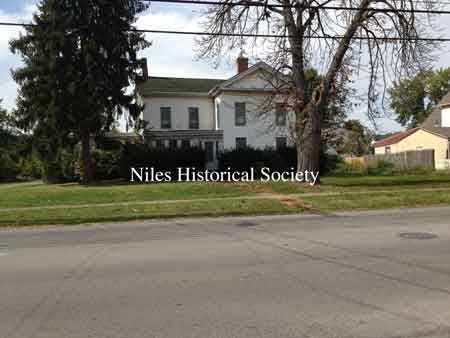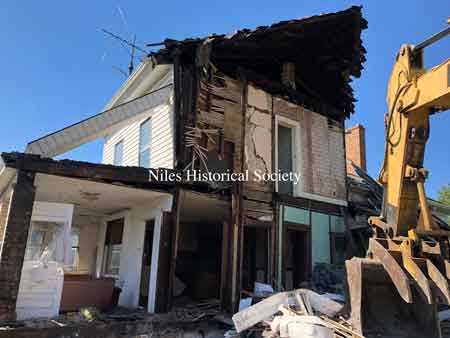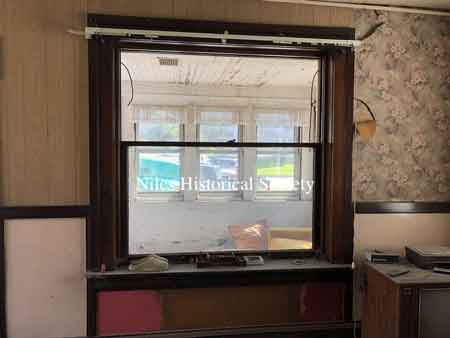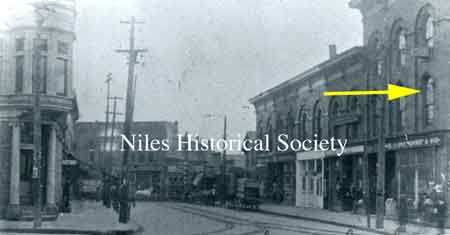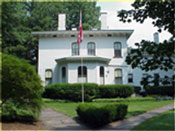
Ward-Thomas Museum

|

The
History of the H.H. Mason Residence in Niles, Ohio
Ward — Thomas
Museum
Home of the Niles Historical Society
503 Brown Street Niles, Ohio 44446
Click
here to become a Niles Historical Society Member or to renew your membership
Return to the Homepage
Click
on any photograph to view a larger image, click on image again to zoom
into photograph. |
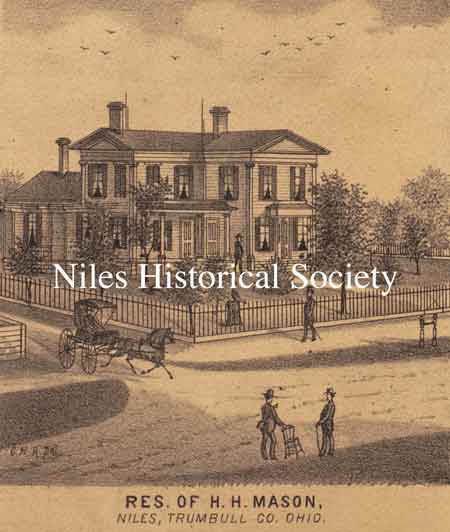
Drawing of the H.H. Mason residence
taken from the 1874 Everts Trumbull Atlas. PO1.432 |
The
History of the H.H. Mason Residence.
Ambrose Mason
led the line of Masons here in 1835. He started the first mercantile
store with Josiah Robbins, who had married Mason’s
daughter, Electa, after the death in 1843 of his first
wife, Maria Heaton. Maria Heaton was the daughter of
James Heaton, founder of Niles, who built the first iron
furnace in 1809. Judge Ambrose Mason in 1843 was chosen postmaster
of Niles, being the only one considered for the position.
Harry H. Mason, his distinguished son, was born in New
York in 1819. In 1842 he opened a store also, which served the
Heatons, James Ward, William McKinley Sr. and others.
He was also assistant postmaster.
H. H. Mason(Henry) succeeded his father as Postmaster, was the
first mayor elected after Niles was incorporated as a village
in 1866, a downtown merchant and one of the builders of the Mason
block at the southeast corner of Main and State streets(Built
prior to 1882).
The residence of H. H. Mason was located on Vienna Avenue in Niles.
Mason moved into this homestead in 1859. It was here that he held
court and as Mayor of Niles, earned $100. a month. He was also
president of the City National Bank which was founded in 1893. |
|

H.H. Mason
PO1.1105 |
City
Hall Then Stood Where Mckinley Memorial Is Now. By
the sixties(1860), Niles had become an important village and the
need for a more adequate form of government organization was felt.
On August 27, 1864, a petition was presented to the county commissioners
asking for incorporation.
The petition was granted and the
first municipal officers, elected in 1866, were: H.H. Mason,
mayor; James Draa, recorder; and as councilmen, James
Ward, Jr., William Davis, David Griffiths, Richard Holeton, and
Henry Schaffer.
The city hall, a wooden structure,
stood on the site of the McKinley Memorial. The first fire department,
a voluntary organization, was formed in 1870 and served with a
second hand engine brought from Pittsburgh by James Ward. This
fire equipment was purchased in 1875 and replaced in 1898. |
|
| 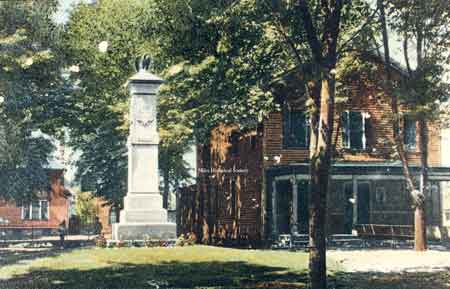
View of the Town Hall and
Civil War Monument.
The Town Hall was demolished in
1915 to make room for the McKinley Memorial Building.
PO1. 206 |
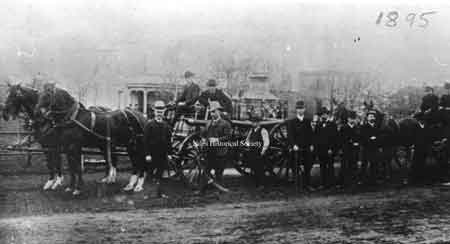
1895 photograph of the Niles fire
department horsedrawn fire engine with the city building and Civil
War Monument in the background. PO1.376 |
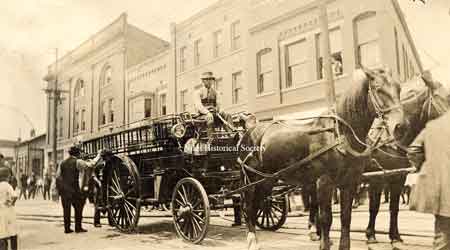
View of a horsedrawn fire engine on State Street.
The building on the right is Guarnieri’s
Confectionary Store. The building on the left is the old Verbeck
(later the Warner) Theatre. PO1.1591 This photo
was taken about 1900. |
|
| |
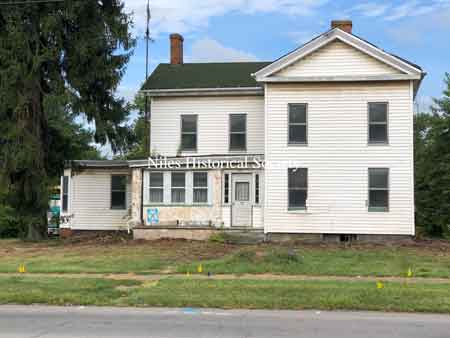 |
Two
views of the H.H. Mason residence as it appeared in the Fall of
2018. The left view shows the building with tress and shrubbery.
The right view shows the residence
as it is being prepared for demolition in the Fall of 2018. |
|
| |
Mason residence shown as it is
being demolished. The barrel in the attic would have water pumped
up into it to supply water for the shower on the second floor.
Much of the interior matrials
of the residence were salvaged for sale: fireplace mantel, wood
beams, wainscoating, granite steps, old glass.
|
|
|
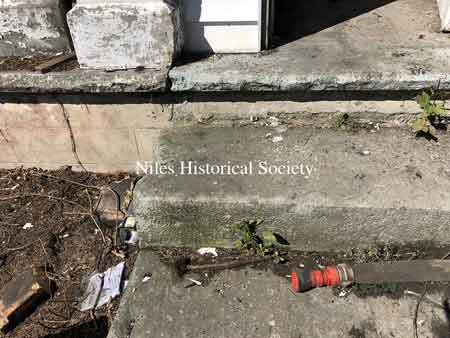 A close-up view of the granite steps on the front
porch.
A close-up view of the granite steps on the front
porch. |
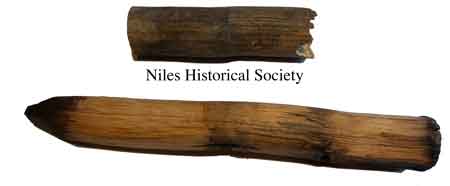
These white oak wooden pins were used to lock the
two parts of a support beam together as shown in image on the right.The
mortise would be hand-drilled with the tenon being inserted into
the mortise opening. A hole would be drilled for the pin which would
be pounded through the mortise and tenon, thereby locking the two
beams together. |
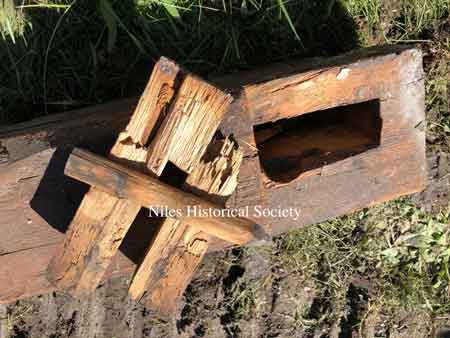 |
|
|
The Mason block or building(built
prior to 1882) was located at the southeast corner of Main and
Mill(State) Streets. In this early 1900s photograph, Sol
Lowendorf’s clothing store occupies the ground level.
All the buildings pictured were
demolished during urban renewal in 1976.
The Safety-Service Complex, which
houses the Fire, Police, and Municipal Court is on this location
today(2019) and opened in April 1977.
|
|
| 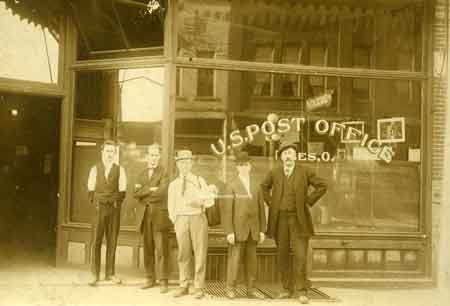
The early post office on East State
Street about 1912. PO1.383 |
The U.S.
Post Office opened in 1842 and was located on Furnace Street(State
Street) near the curve.
Until 1834 the settlement was
appropriately called “Heaton’s Furnace”, but
James Heaton gave it a new name “Nilestown” in honor
of Hezekiah Niles, editor of the Niles Register, a Baltimore
paper, who’s Whig (early political party) principles Heaton
greatly admired.
Nilestown remained the name until
1843 when Postmaster Ambrose Mason for convenience shortened it
to “Niles” and that is how Niles got its name.”
Frank Mears, Pete McDonald,
and Adam Fischer are shown in the photograph.Adam Fischer
built the Bert Street and Third Street Schools in 1905 as well
as the City Building on State Street in 1927. |
|
|
|
|








